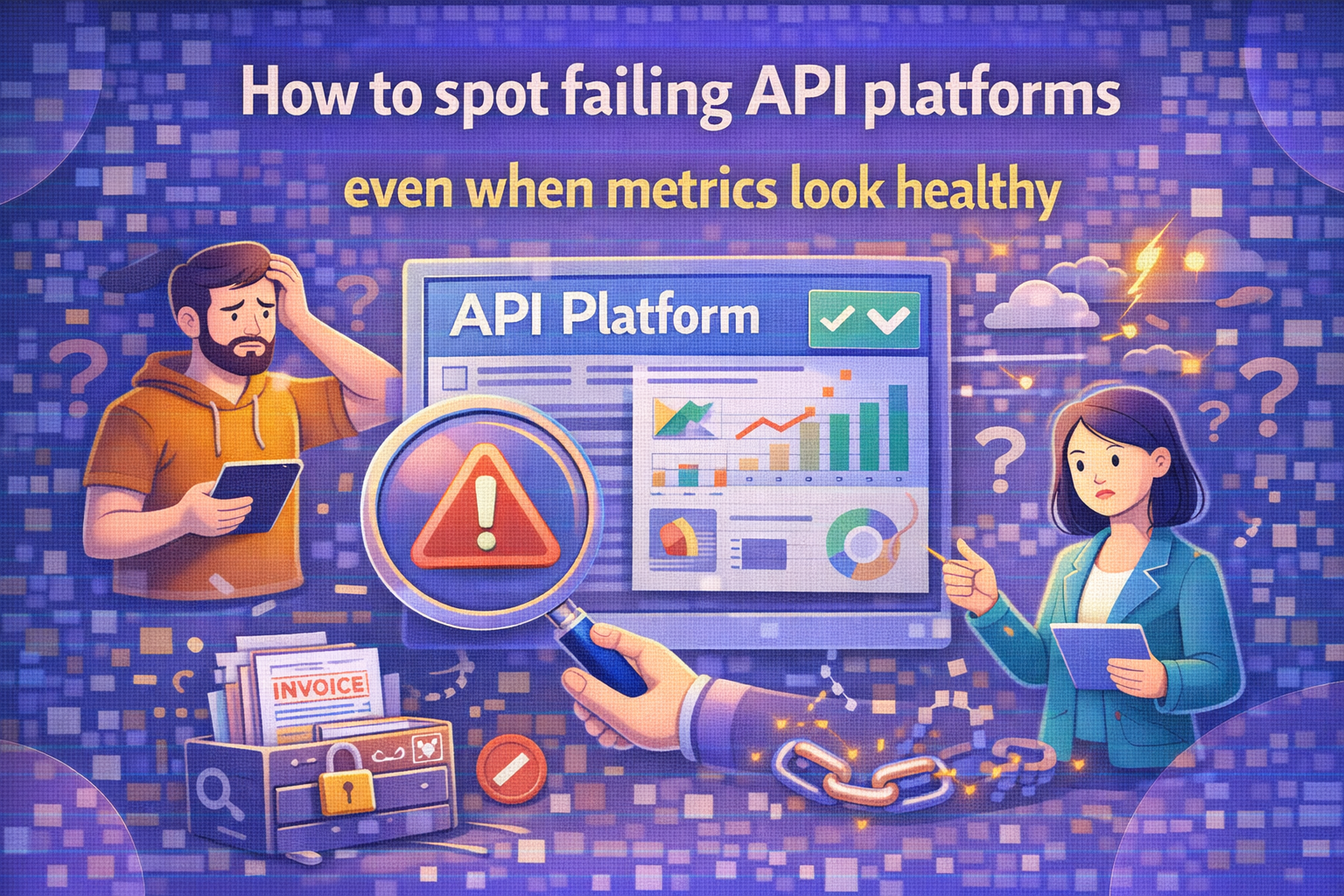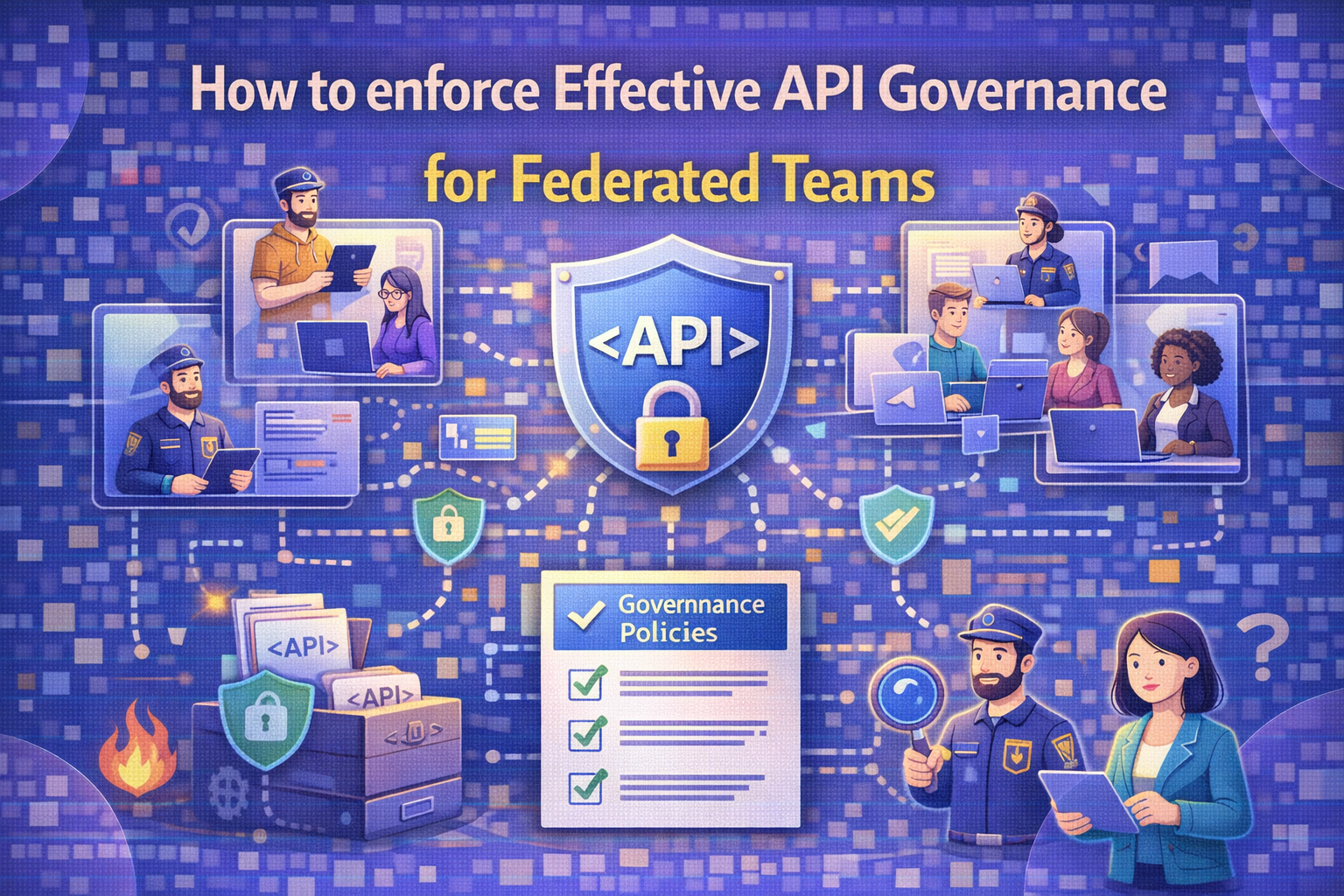.webp)
APIs were once just quiet enablers, connecting systems, exchanging data, powering frontends. But that role is evolving fast. In a world where AI no longer just responds with answers but takes action, APIs are becoming the control layer for autonomous execution. Welcome to the era of Agentic AI: AI systems that act like software agents, deciding, planning, and calling APIs on their own.
For API architects, this isn't a future problem. Agentic AI is already reshaping how internal and external APIs are discovered, invoked, and governed. It’s raising new questions: How do we design endpoints that agents can reason with? How do we embed trust, enforce guardrails, and avoid overexposure?
In this blog, we break down what Agentic AI really is, how it differs from traditional generative AI, and how API teams should prepare their infrastructure, governance models, and product thinking. Whether you're already experimenting with AI agents or just preparing for the inevitable, this blog will help you navigate the architectural shift that’s underway.
What is Agentic AI?
Agentic AI refers to a new class of artificial intelligence systems that go beyond generating content or responding to prompts, they act with purpose. Unlike traditional generative AI, which produces text, images, or code based on static inputs, agentic AI systems are autonomous. They pursue defined goals, plan sequences of actions, interact with tools (often APIs), adapt to context, and refine their behaviour over time.
At the core of agentic AI is the idea of agency: the ability to take initiative, make decisions, and execute tasks in dynamic environments. These agents don’t just answer questions, they perform actions. For example, an agentic AI could be tasked with “generate a weekly sales report,” and autonomously retrieve data from multiple APIs, analyse trends, write a summary, and email the results, without further human intervention.
These systems typically include components like memory, goal-oriented planning, tool-use capabilities, and contextual awareness. This enables them to operate not as chatbots, but as decision-making assistants or autonomous services. They're often built using frameworks like LangChain, CrewAI, or Microsoft's Autogen, and increasingly rely on well-structured APIs to interact with systems securely and efficiently.

How does Agentic AI work?
Agentic AI operates by taking a high-level goal and autonomously breaking it down into actionable steps. It respond to instructions by reasoning, planning, and interacting with external systems to complete tasks. These systems are built with several key components:
- Memory (to retain context and track progress)
- Planning (to organise tasks in sequence)
- Tool use (typically APIs)
- Feedback evaluation (to adapt based on results).
For example, imagine a marketing analyst asks an AI agent to “compile competitor pricing data and summarise trends.” An agentic AI would identify relevant data sources, call APIs from market intelligence platforms, compare product-level pricing, detect patterns, and generate a report. It might also consider emailing it or updating a dashboard. All of this would be done iteratively, with the agent deciding which step to take next based on what it learns along the way.
This looped, goal-driven behaviour is what separates agentic AI from traditional LLM use cases. It’s not just about generating a single output, but continuously observing, acting, and refining until the objective is achieved. By embedding tool-use capabilities and adaptive logic, these systems bring a new level of autonomy and utility to enterprise workflows, particularly in environments rich with APIs.
Key components of Agentic AI
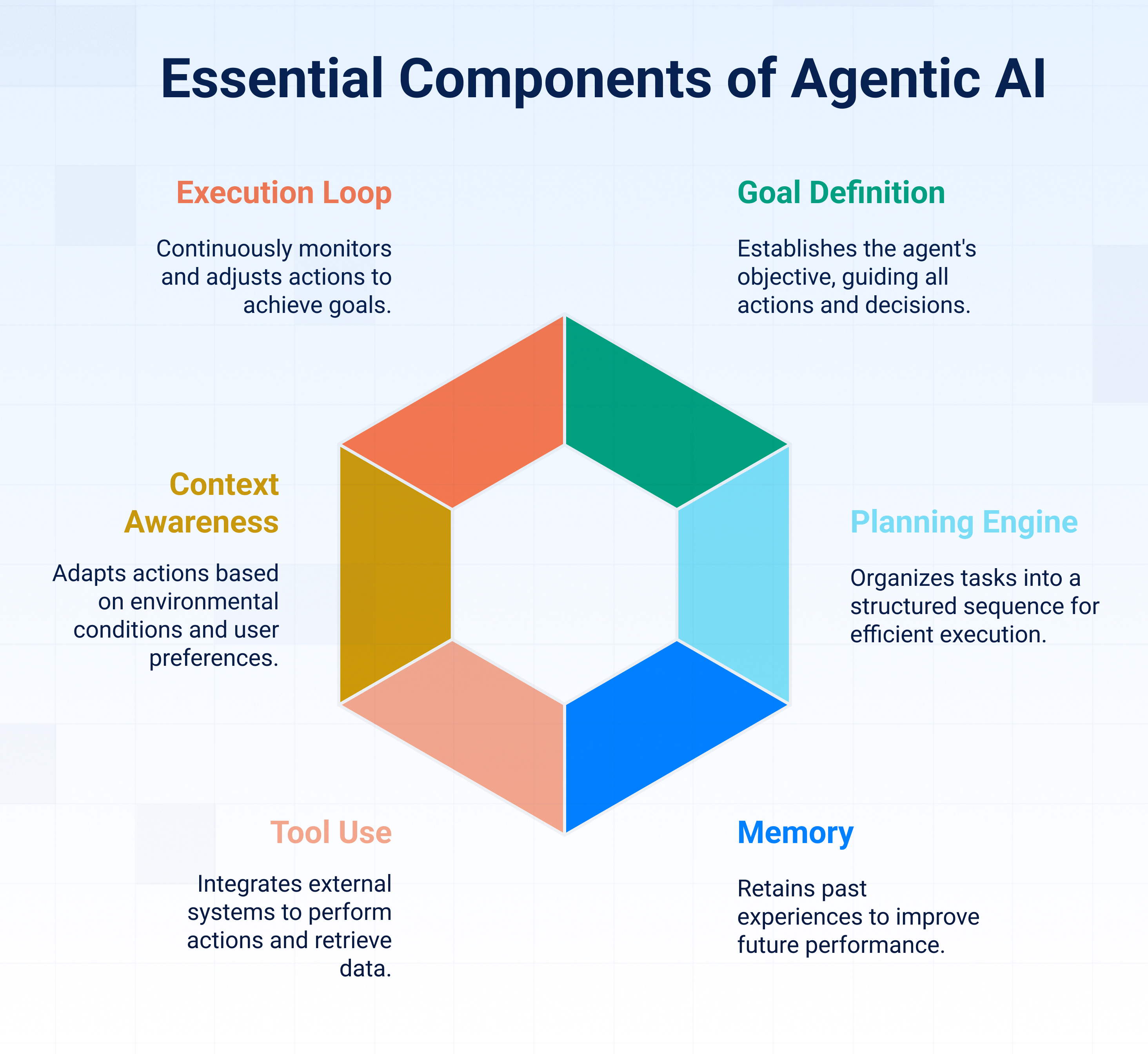
Agentic AI systems are built using modular components that enable them to act autonomously, adapt to new information, and complete multi-step tasks. Each component plays a critical role in making the agent intelligent, interactive, and reliable. Here are the essential building blocks:
- Goal definition: Every agent starts with a goal. This could be user-provided or system-triggered. The goal acts as the anchor for all decision-making. Unlike prompt-based systems, agentic AI doesn’t just respond once; it actively works toward fulfilling the defined objective through multiple steps.
- Planning engine: Planning is what gives the agent structure. It breaks down the goal into a series of subtasks or steps, often deciding which to prioritise or sequence based on dependencies. Some agents use tree-based planners or task graphs to manage this flow dynamically.
- Memory: Memory allows the agent to retain information across tasks or sessions. It can recall past results, errors, and interactions, which is critical for refining its behaviour over time. Short-term memory helps within a session, while long-term memory supports learning and continuity.
- Tool use (API integration): Agentic AI interacts with external systems using tools, usually APIs. Tool use is where the agent moves beyond thought into action, triggering workflows, retrieving data, or submitting forms. A robust agent will know when and how to call each tool safely.
- Context awareness: Context awareness allows the agent to adapt based on its environment. It interprets not just the instructions but also the conditions, like user preferences, time constraints, or real-time data, which helps in making informed decisions and avoiding irrelevant actions.
- Execution loop: Instead of a one-time response, agentic AI operates in a loop: Observe, plan, act, evaluate, and repeat. This loop ensures the agent can monitor progress toward its goal, adjust its approach, and continue acting until the goal is reached or revised.
Types of Agentic AI architecture
Agentic AI systems are designed using different architectural patterns depending on the scale, autonomy, and coordination needed. Choosing the right architecture is critical as it affects how agents collaborate, achieve goals, and how APIs are orchestrated. Below are the most widely adopted and emerging architectures, each suited to different use cases.
1. Single-agent architecture
This is the simplest form of agentic AI: a single, autonomous agent is responsible for completing a given task from end to end. It plans the workflow, decides which APIs or tools to use, executes the necessary actions, and evaluates the results, all within a single reasoning loop.
Single-agent systems are easier to manage, debug, and deploy. They are ideal for straightforward automation tasks that don’t require collaboration or delegation.
Example: An AI agent used by a sales team that, when asked to “summarise last week’s lead conversions,” calls the CRM API, fetches lead data, analyses it, and generates a summary, all in one flow.
Strengths
- Easy to deploy and reason about
- Works well for repeatable tasks
- Lower infrastructure overhead
Limitations
- Not scalable for complex workflows
- Limited specialisation
- Becomes inefficient if required to manage multiple roles or contexts
2. Multi-agent (collaborative) architecture
In this model, multiple agents work in parallel or sequence, each handling a specialised part of the overall goal. These agents can communicate directly or through shared memory. Each agent may use its own reasoning and toolset but contributes to a common objective.
This architecture mirrors real-world collaboration: just as departments within a company handle different tasks, agent clusters can divide responsibilities. Coordination and state sharing are managed either via a shared orchestration layer or an external memory graph.
Example: A customer support automation system where one agent parses incoming queries, another retrieves account data via APIs, a third drafts a response, and a fourth checks tone and policy compliance before sending it.
Strengths
- Specialised capabilities per agent
- Modular and reusable components
- More scalable and fault-tolerant
Limitations
- Requires robust coordination logic
- Increases complexity and inter-agent communication overhead
- Risk of conflicting decisions if not well managed
3. Hierarchical agent architecture
This approach introduces a control hierarchy, one or more supervisory agents (managers) delegate tasks to sub-agents (workers). The manager agent is responsible for goal tracking, error handling, agent selection, and workload distribution. Worker agents may be short-lived or persistent, depending on their function.
This architecture is best for complex projects or multi-step workflows where tasks need sequencing, retries, and real-time monitoring.
Example: A DevOps automation system where the manager agent oversees feature deployment. It delegates code testing to one agent, infrastructure provisioning to another, and compliance checks to a third, each using relevant APIs (CI/CD, cloud, audit tools).
Strengths
- Clear control and accountability
- Supports retries and fallback logic
- Easier to monitor at scale
Limitations
- Risk of central manager becoming a bottleneck
- Complex state handling
- Dependency on effective task routing and trust logic
4. Agent-as-a-Service (AaaS)
Agent-as-a-Service is a modern paradigm where agents are deployed as reusable, composable services, each accessible via API. These agents expose their capabilities through endpoints, much like microservices, and can be triggered by other systems or agents.
This makes agentic capabilities portable and easy to integrate into existing systems without major rewrites. Agents can be domain-specific (e.g., invoice processing, data summarisation) and published internally or to partner ecosystems.
Example: A bank might host an "identity verification agent" accessible via secure API. Any internal or external service (like a loan onboarding system or fintech app) can call this agent to validate documents, check KYC status, and respond with a verdict.
Strengths
- Easy to plug into existing workflows
- Scales well via API infrastructure
- Promotes reuse and modularity
Limitations
- Stateless by design unless paired with external memory
- Requires strict governance and rate-limiting
- Depends on robust API security
5. Swarm or decentralised architecture
In swarm-based setups, agents operate independently with minimal or no central coordination. They follow shared behavioural rules and adjust based on the behaviour of other agents and the environment. Communication is implicit as emergent behaviour arises from local decisions rather than central planning.
Swarm architectures are ideal for dynamic environments where flexibility, resilience, and speed are more important than strict control.
Example: A decentralised logistics system where delivery agents autonomously optimise their routes based on local traffic, weather, or fuel levels, sharing updates in real-time with nearby agents to improve collective performance.
Strengths
- Highly resilient and adaptable
- Scales horizontally
- Reduces single points of failure
Limitations
- Difficult to coordinate complex workflows
- Harder to debug or trace decisions
- Requires strong consensus protocols or reward signals
How API architects can prepare for the Agentic AI shift?
Agentic AI changes how APIs are consumed, from human-triggered, one-time calls to autonomous, multi-step interactions. This demands a fundamental shift in how APIs are designed, documented, secured, and governed. API architects play a critical role in ensuring that enterprise systems are ready to support these intelligent agents. Here’s how to prepare:
- Design for machine-to-machine consumption: Agents don’t read docs like humans. APIs must be self-descriptive, machine-readable, and semantically clear. Use standardised schemas (like OpenAPI), meaningful parameter names, and well-defined response structures to make endpoints agent-friendly.
- Embrace the Model Context Protocol (MCP): MCP is emerging as the standard to make APIs "agent-ready" by exposing metadata like usage context, auth requirements, and rate limits. Architects should prepare to wrap APIs with MCP descriptors or adopt platforms that support it natively.
- Implement granular access controls: Since agents operate autonomously, fine-grained authentication and authorisation become non-negotiable. Apply OAuth scopes, API keys with permissions, and identity-aware gateways to avoid misuse or privilege escalation.
- Optimise for latency and reliability: Agents often operate in tight loops, where latency in one API can stall the entire task. Focus on performance tuning, caching, and graceful error handling to keep agent workflows responsive and resilient.
- Expose APIs as capabilities, not just endpoints: Think in terms of actions or services an agent can perform. For example, rather than just exposing a data-fetching API, package it as a capability like “generate user insight” or “summarise transactions.” This makes integration easier for planners and reasoning engines.
- Add observability and monitoring hooks: Ensure all API calls made by agents are traceable. Implement distributed tracing, logging, and dashboards that flag anomalous access patterns or behaviour changes, crucial for trust, debugging, and governance.
- Collaborate with AI and security teams early: The agentic shift is cross-functional. Work closely with LLM engineers, AI ops, and security teams to align on standards, test scenarios, rate limits, and escalation paths. API design is now central to the success (or failure) of autonomous agents.
Agentic AI vs. Generative AI: What’s the Difference?
Generative AI and Agentic AI are often used interchangeably, but they solve fundamentally different problems. While generative AI focuses on creating content from prompts, agentic AI is about achieving goals through action, planning, and tool use. Understanding their differences is key to designing the right API and system interfaces for each.
Benefits of Agentic AI in API-Driven Environments
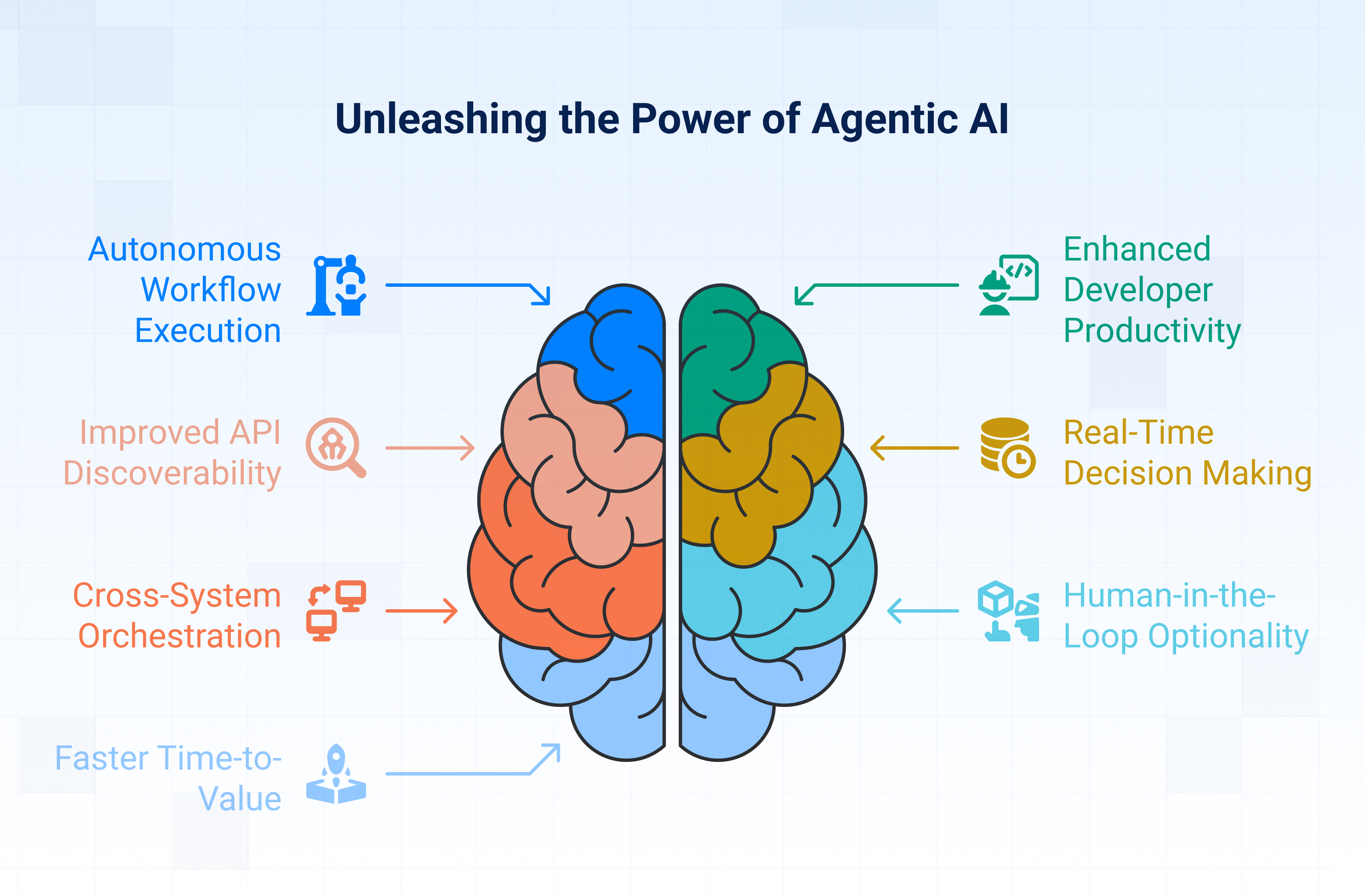
In API-first organisations, Agentic AI unlocks new levels of automation, intelligence, and scale. By combining LLM reasoning with dynamic API interaction, these agents can not only understand goals, but execute them, across systems, with minimal human input. Here are the top benefits tailored for API-driven environments:
1. Autonomous workflow execution
Agentic AI can execute entire workflows by calling multiple APIs in sequence without constant human prompting. This reduces the need for orchestration logic hardcoded into backend systems and enables more flexible, task-based automation.
2. Enhanced developer productivity
Developers can offload repetitive tasks like documentation generation, API testing, or integration setup to agentic systems. By handling these operational chores, agents free up developer time for higher-value work like design and strategy.
3. Improved API discoverability and usage
Agents can search across internal API catalogs, understand descriptions, and select the right endpoints dynamically. This reduces friction in large organisations where APIs exist but are underused due to discoverability issues.
4. Real-time decision making
Agentic AI doesn’t just respond, it reasons. It can use APIs to fetch real-time data (e.g. prices, risk scores, service availability) and adjust its decisions accordingly, leading to smarter, context-aware automation.
5. Cross-system orchestration
Agents can bridge APIs across departments or vendors, handling authentication, request formatting, and data stitching. This makes cross-platform workflows easier to build, even when underlying systems weren’t designed to work together.
6. Human-in-the-loop optionality
While agents can operate autonomously, they can also pause, request feedback, or escalate decisions based on API responses. This flexible trust model allows organisations to gradually scale autonomy without losing control.
7. Faster time-to-value for APIs
By embedding APIs into goal-driven agents, organisations can see value faster—APIs aren’t just “ready” but actively consumed. This is especially important for internal APIs, where adoption often lags behind development.
Real-World use cases of Agentic AI in enterprise APIs
Agentic AI is no longer a futuristic concept, it’s already being used by enterprises to unlock automation across departments, platforms, and business functions. When paired with well-designed APIs, agentic systems can plan, act, and adapt at scale. Here are the high-impact use cases that demonstrate its practical value in enterprise environments:
1. Automated sales reporting and insights
Enterprises often struggle with fragmented CRM data across regions and business units. An agentic AI can be tasked with “generate the weekly sales report,” and it will autonomously query CRM APIs (like Salesforce), aggregate metrics by geography or team, detect trends, and generate both summaries and visuals. It can even send updates via Slack or email. This replaces hours of manual reporting with a reliable, repeatable flow.
2. Compliance monitoring across APIs
In regulated industries like banking or healthcare, APIs must comply with security and audit policies. An agentic AI can be configured to routinely scan API metadata, access logs, and response schemas to identify non-compliant patterns. By integrating with internal monitoring APIs and documentation systems, the agent can flag risks and even suggest corrective actions, turning passive observability into active governance.
3. IT ticket resolution and routing
Enterprise IT service desks are flooded with repetitive tickets like password resets, VPN access, software installations. An AI agent can interpret the intent behind each ticket, match it with internal service catalog APIs, resolve it autonomously (e.g., by calling identity or provisioning APIs), or route it to the correct team. This reduces resolution time from hours to minutes and boosts agent productivity.
4. Customer onboarding automation in banking
In financial services, onboarding a new customer involves validating KYC documents, setting up accounts, and syncing data across systems. An agentic AI can coordinate this process by calling APIs for document verification, fraud checks, account creation, and CRM updates. It can handle edge cases with human-in-the-loop escalation, improving speed and reducing onboarding friction.
5. Procurement and vendor management automation
Large enterprises deal with hundreds of vendor interactions, from onboarding to payment reconciliation. An AI agent can automatically collect quotes via vendor APIs, compare prices, flag anomalies, generate purchase orders, and track approvals. By integrating with procurement, ERP, and finance APIs, the agent ensures procurement happens on time and in compliance with internal policies.
Challenges of implementing Agentic AI architecture
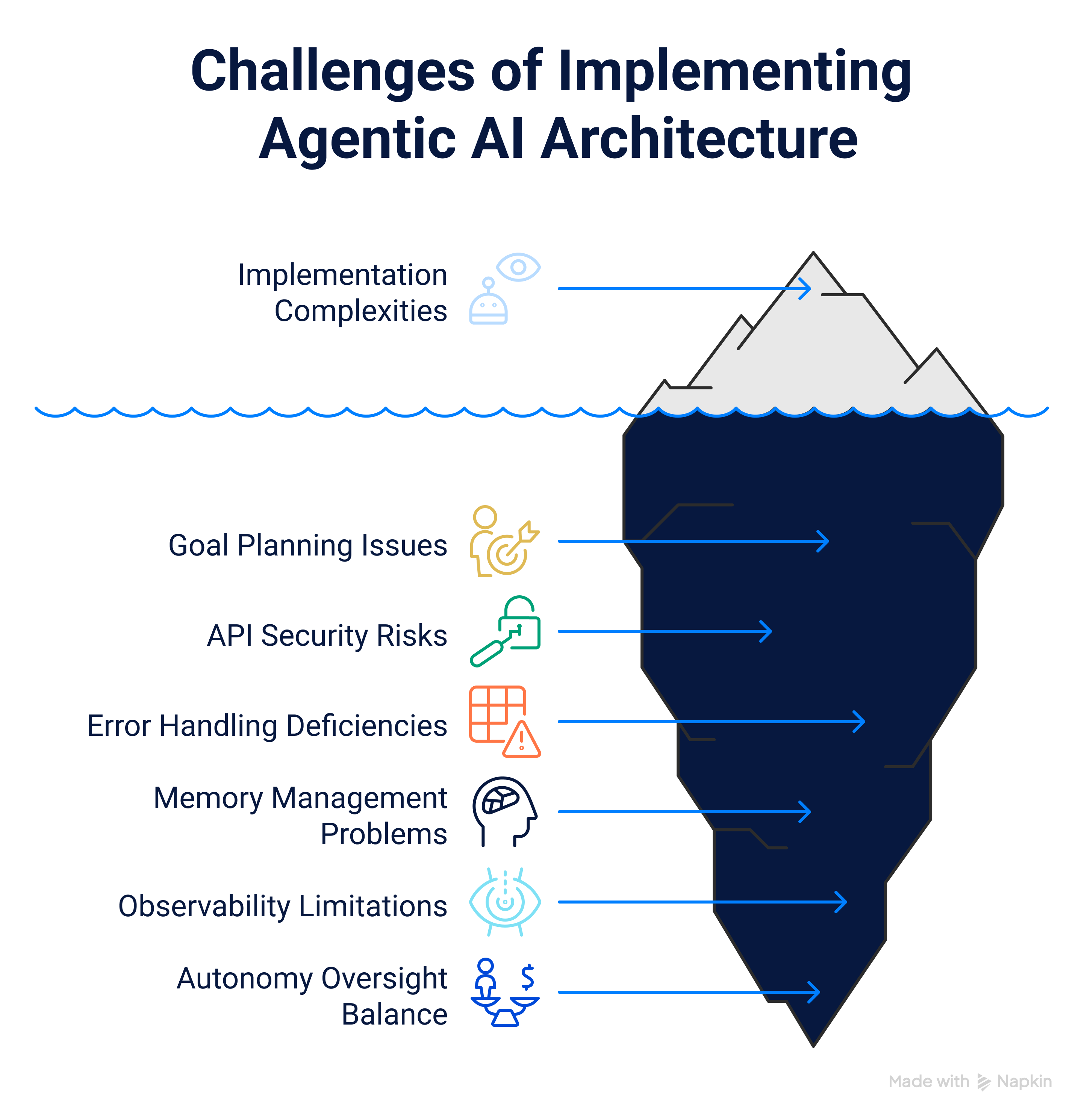
While Agentic AI offers exciting opportunities for automation and intelligence, implementing it in real-world enterprise systems isn't straightforward. The shift from prompt-based AI to autonomous agents introduces technical, architectural, and governance complexities. Here are the key challenges enterprises must address when adopting agentic AI architectures:
- Reliable goal planning and execution: Unlike simple chatbots, agentic systems must interpret broad goals and break them into meaningful, executable steps. This requires robust planning algorithms and context-aware reasoning. If the plan is flawed or misaligned with system constraints, the agent may waste resources or act unpredictably.
- Secure and contextual Tool/API access: Agents typically call APIs to get things done, but granting them access to enterprise APIs raises serious security concerns. Ensuring proper authentication, authorisation, rate limiting, and scope restriction becomes critical, especially when agents operate autonomously without human oversight.
- Error handling and recovery mechanisms: In dynamic environments, APIs can fail, return partial data, or behave inconsistently. Agentic systems must be built with resilient error handling, retry logic, alternative planning paths, and fallback strategies. Without this, a single failure can break the entire loop or lead to incomplete outcomes.
- Memory management and state persistence: Agents often need short-term and long-term memory to reason effectively, remembering past actions, user preferences, or intermediate results. Implementing this in a scalable and secure way (especially across sessions or workflows) is a non-trivial architectural challenge.
- Monitoring, observability, and auditing: Autonomous behaviour makes agents harder to debug and monitor. Enterprises must build observability into the agent’s decision loop by logging actions, visualising plans, and tracking API calls to ensure accountability and traceability, especially in regulated sectors.
- Balancing autonomy and human oversight: Not all tasks should be fully automated. Striking the right balance between agent autonomy and human-in-the-loop checkpoints is critical. Enterprises must design agents that know when to act, when to pause, and when to escalate, without undermining efficiency or control.
Precautions and governance best practices
Deploying agentic AI in enterprise environments demands more than technical accuracy, it requires trust, transparency, and tight governance. Because agents can act on behalf of users and systems, even minor missteps can lead to large-scale errors or security breaches. Let’s take a look at the key precautions and governance practices to help enterprises deploy agentic AI safely and effectively:
1. Implement role-based access and scoped permissions
Agents should never have blanket access to all APIs or services. Use granular, role-based access control (RBAC) to limit each agent’s capabilities to only what is necessary for its task. This helps contain potential damage in case of misbehaviour or compromise.
2. Require explicit goal definitions and boundaries
Always define clear task scopes, limits, and termination criteria for agents. Instead of vague instructions like "optimise operations," use bounded goals like "reduce cloud usage under $5k/month." This prevents unintended side effects and ensures responsible execution.
3. Enforce API call limits and rate policies
Agents operating in loops can easily overwhelm systems if left unchecked. Apply strict API rate limits, circuit breakers, and usage quotas to prevent abuse, especially for high-cost or sensitive endpoints like finance, identity, or data extraction APIs.
4. Build agent auditing and activity logs
Every action taken by an agent such as an API call, plan update, or decisio should be logged and made traceable. This ensures compliance, enables root cause analysis, and provides evidence trails in industries with regulatory obligations.
5. Introduce human-in-the-loop for critical tasks
For tasks involving compliance, finance, or customer experience, agents should request human review or approval before taking action. This can be done through pre-execution confirmation prompts, workflow pauses, or multi-step validation pipelines.
6. Regularly test agents in simulated environments
Before deploying agents in production, test them in sandbox environments with real APIs and data mocks. Simulations help uncover unexpected behaviours, logic errors, and edge cases, without real-world consequences.
7. Monitor for drift and unexpected actions
Over time, agents may evolve their plans or respond differently to changing API behaviours. Continuous monitoring and anomaly detection systems should flag deviations from expected patterns to ensure ongoing alignment with business policies.
8.Average Time to Implement Agentic AI Across Departments
Most enterprises begin with pilot projects in 8–12 weeks for one function, such as IT support or compliance scanning. Scaling to multiple departments often takes 6–12 months, depending on API maturity, security reviews, and change-management needs. Early investment in MCP-ready APIs and robust governance shortens rollout timelines and reduces integration risks
Final thoughts
Agentic AI is not just another evolution of AI, it’s a paradigm shift in how software interacts with the world. For API architects, it’s a call to action as APIs are no longer just interfaces for humans, but control surfaces for intelligent agents. Preparing for this shift means rethinking API design, documentation, governance, and observability to support autonomy, safety, and scale.
Those who adapt early will enable their organisations to move faster, automate more intelligently, and unlock entirely new forms of productivity. As AI agents become more embedded in enterprise workflows, the API layer becomes the foundation they build on, and the responsibility to make it robust, secure, and agent-ready starts with you.
Frequently asked questions:
1. What is Agentic AI?
Agentic AI refers to autonomous AI systems that can reason, plan, and take actions using APIs and external tools without constant human prompts. These agents orchestrate workflows across services, enabling more adaptive, real-time decision-making for complex enterprise environments.
2. How does MCP help reduce API call costs in large-scale AI systems?
The Model Context Protocol (MCP) provides standardized metadata like rate limits, caching, and access rules that allows agents to plan API calls more efficiently. This reduces redundant requests, minimizes latency, and can cut cloud and API usage costs by double-digit percentages at scale.
3. Why is Agentic AI important in dynamic environments?
In industries like logistics, finance, or IoT, conditions change constantly. Agentic AI systems use robust, discoverable APIs to adapt in real time re-planning actions as data shifts. This adaptability improves responsiveness, reliability, and ROI in fast-moving, data-rich environments.
4. How can a developer portal support Agentic AI adoption?
A robust developer portal centralizes API documentation, onboarding flows, and governance. It helps internal and external developers discover and use MCP-ready APIs quickly reducing time-to-first-success and scaling agentic AI initiatives across teams.
You’ve spent years battling your API problem. Give us 60 minutes to show you the solution.
.svg)



